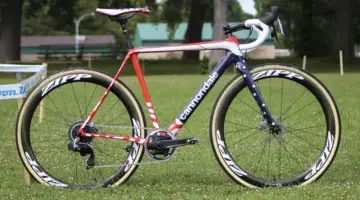by Molly Hurford
With the huge response we got to our most recent Mechanical Monday topic of disc brakes, we had to reach out to the man who has helped to start the revolution. Stu Thorne, the owner of CyclocrossWorld.com, chatted with me for a bit about his thoughts on disc brakes. Last season, Thorne put his Cannondale-CyclocrossWorld.com rider Tim Johnson on them for a few races, and Johnson was favorably impressed. For more on Johnson’s disc brake views though, you’ll have to wait for our feature story on him in the next print issue. (Can’t wait? Check out Tim Johnson with his Cannondale SuperX)
Thorne is obviously a staunch advocate of disc brakes, and his riders have been the first to embrace the trend. That said, the first thing he told me was that he understands where some of the mechanics were coming from in their hesitation to push discs on cyclocross bikes. “I’ll be straight about it. I think it can be expensive but I don’t think it’s as big a deal as people are led to believe. Mechanical disc brakes don’t cost much money. The wheel issue … yes, I agree with one of the people you interviewed who said a rider might already have an arsenal of wheels and now he or she is going to have to start to think about switching things over, which can be expensive. And I do totally agree with the one comment about how if you’re just getting into the sport and buying a bike, you should certainly look at disc brakes.”
However, that doesn’t mean that Thorne agreed with the mechanics who chimed in, entirely. “There was one comment that someone made where he said as far as he could see, they were all 130 mm spacing and from what I understand, it’s the opposite, it’s 135 mm spacing, which, if you were creative, you could use some of your two-niner wheels. It’s not going to be cut and dry, but there is some ability to utilize other stuff.”
Having had a pro racer riding discs in a few different races, Thorne has made some observations about what the disc brakes can be good for, and his conclusions might be contrary to popular belief.
“Contrary to what people think disc brakes are good for, which is that they’re good when it’s super muddy, because you’re going to have better braking and all that, we found that when we did our racing in California this season and the weather was bone-dry, Tim [Johnson] was able to do certain things on the bike that he felt were advantageous on those courses. And racing against Ben Berden, Berden said the same thing. It wasn’t like a Tim sales pitch or a SRAM sales pitch. It was funny because Berden saw exactly what was happening and Berden was the one who came to us the next day and said, ‘Yeah, Tim was beating me in all these corners because he’d come in super hot and he’d scrub off speed with his brakes.’ He was actually able to turn the bike with the brakes and then accelerate faster out of the corner and it was just killing Berden every lap. It was an interesting take on it because it was a bone-dry course, and Tim had just won the weekend before on a super muddy course, so I see it as an advantage in a couple of different areas. I think a lot of people aren’t thinking that. They’re thinking, ‘Oh yeah, it’s going to be great in the mud.'”
If Tim Johnson is the rider who most enjoys trying out new technology, it only makes sense, because he and Thorne have the same philosophical ideas about it. Thorne told me, “If you set up your cantilever brakes properly, you can make them work pretty good, there’s no question. There’s probably sometimes where disc brakes might not be a huge advantage. But I think for a beginner especially, you can have brakes that actually work, and it’s a better thing for the rider, for sure. Why should we be stuck in 1978? I think that years ago, people were taking a bunch of their road stuff and putting it on their cyclocross frames. That’s not happening now. There’s a cyclocross bike in the garage, along with a mountain bike and a road bike, so why are we riding this old stuff? If you’re going to have a dedicated bike, go for it.”
Lastly, Thorne wanted to make people aware of all of the options coming down the line, and he and I spent a good chunk of time discussing the merits of having two cheaper bikes versus one great one and one bike specifically for the pit. “There was a comment in there that there just isn’t much available, especially on the high end, and I’m just like, ‘are you kidding me?’ Look at Ridley, for instance. They’ve made a huge investment in disc brakes. And OK, there’s not a SRAM Red bike with disc brakes, but there’s an Ultegra. And that’s pretty darn good. ”
Of course, it’s not just Cannondale-CyclocrossWorld.com that’s leading the disc-brake charge. Check out our “video tour” of the new Felt 65X Disc-Equipped bike.
Will you be riding disc brakes this year? Let us know in the comments!





























